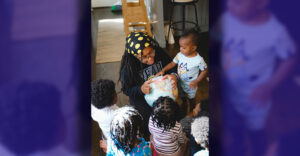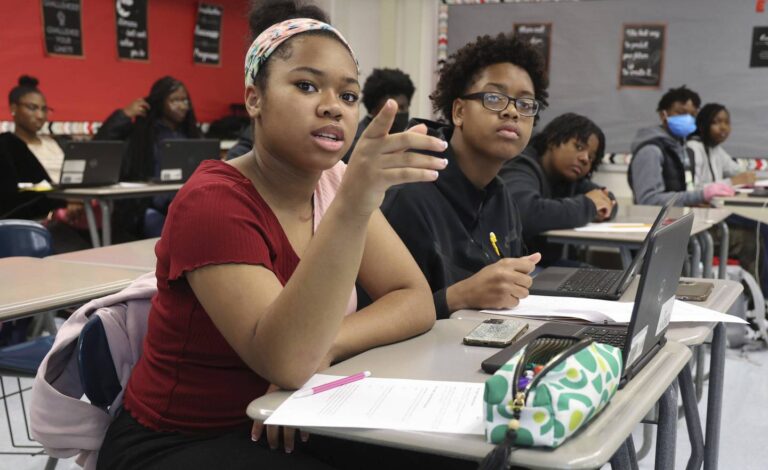2022 marks the first complete Illinois Report Card since 2019. The Illinois School Board of Education released the latest report card for the state Thursday morning.
While the pandemic’s affects are still being felt, as the data indicates, ISBE is counting some notable wins in the area of high school graduation rates, students’ academic growth and an increase in numbers of the teacher workforce.
Advertisement
The number of students who saw academic growth in English language arts in grades four through eight in 2022 increased to 52 percent from 50 percent in 2019, and growth in math saw an increase to 54 percent in 2022 from the 50 percent in 2019. (Growth measures how much students progress in one year compared to other students in their same grade statewide who started at the same baseline.)
This information is culled from the Illinois Assessment of Readiness, or IAR, the state’s federally mandated measurement of students’ mastery of the Illinois Learning Standards in language and math. ISBE officials said while growth slowed during the height of the pandemic, the improvement over pre-pandemic growth levels is evidence the state is on the “right track in recovery efforts,” and they attribute the success to statewide investments of federal pandemic relief funds.
Advertisement
“Growth is highly responsive to factors like quality teaching, evidence based interventions and school improvement efforts,” said Carmen Ayala, state superintendent of education. “Accelerated growth reflects the investments schools, districts and the state made to get students back on track.”
More than 500 African American and Hispanic teachers were added to the state’s workforce last year, showing inroads being made into diversifying the profession for the past four years, according to state school officials. They were among the 2,500 full-time teachers hired in 2022.
Teacher retention also hit a nine-year high this year with 87.6% of teachers returning to the same school year to year.
“Last year, we saw the highest teacher retention rate since we started reporting this metric in 2014,” Ayala said. “We’re defying national teacher shortage trends, not only because we’re increasing the number of teachers in the profession in Illinois, but also because we’re keeping more and more of the great teachers that we have.”
Mentorship and coaching programs to help new teachers through their early years were cited as helping in this area, as well as $2 million in federal pandemic relief funds to create affinity groups for teachers of color to build and engage in a supportive community.
Illinois’ four-year high school graduation rate saw the highest number in 12 years — 87.3% — driven by gains for Black and Hispanic students. It’s the highest rate since the Illinois State Board of Education began reporting the graduation rate in 2011. While Black and Hispanic students historically graduate at lower rates than their white and Asian peers locally and nationally, in Illinois, the graduation rates for Black and Hispanic students have grown every year since 2018. The rate jumped 6% for Black students and 5.3% for Hispanic students over the past four years.

“Now this is what equity looks like when we improve supports for historically disadvantaged students — everyone’s performance benefits,” Ayala said.
The rate of ninth graders on track to graduate increased and the percentage of graduates enrolled in remedial courses in state community colleges continues to decline.
Advertisement
Kevin Jauch, executive director of the North Cook Intermediate Service Center and regional superintendent of schools for North Cook Regional Office of Education, said closing the achievement gap is key.
“I see the gains in graduation as very promising, especially because it’s driven by Black and Hispanic students,” he said. “The focus of the State Board of Education now for the last four years, has been addressing minority populations at-risk populations and students that are often underserved. So that’s exciting information. The gains in the workforce … that’s promising, but there’s a lot to do to address the teacher shortage.”
A majority of the roughly 135,000 members of the Illinois Education Association, the state’s largest union, reported seeing shortages this fall in their districts in both teaching and support staff positions, including bus drivers, custodians, paraprofessionals and secretaries, said Kathi Griffin, IEA president.
[ Illinois school report cards 2022: Elementary and middle school results in Chicago and the suburbs ]
Ericka Polanco-Webb, a Burr Ridge mother of six with students at Hinsdale South High School, calls the report card encouraging, especially in terms of teachers of color. As a Black parent in a predominantly white district, she thinks schools are finally seeing the benefit of representation. She would like to see more of that.
“It’s important that children have a depiction of what the world around them looks like and what better way to have those people being educators,” she said. “I would definitely like to see those numbers increase in our district because I think that we do have a deficit in that area.”
Avoca School District 37 Superintendent Kaine Osburn said the information in the report wasn’t eyebrow raising. For a small elementary school district consisting of two schools, he said the data is really important in helping staff look at the individual student level.
Advertisement
“Our overall achievement level is still not where we think it can be and that’s largely due to the pandemic,” he said. “But we anticipate with continued growth that our students will be back to where they should be pretty shortly. We’re very consistent with overall performance. I think our students who are identified with IEPs, we’ve identified that we can do better by them and are looking at ways to do that.”
Ayala found the results from the National Assessment of Educational Progress released on Monday another area of Illinois pride. Known as the “nation’s report card,” the assessment tests hundreds of thousands of fourth and eighth graders across the country and this year Illinois students scored above the national average in both reading and math.
“While the national trend saw declining scores in grade four, Illinois scores remained stable from 2019 to 2022, and above the national averages in both reading and math, despite the disruptions of the pandemic,” she said.
The report card had some points of concern, including chronic absenteeism, which looks at students who missed 10% or more of the school year, approximately 17 days or more with excused or unexcused absences. Nearly 30% of students were chronically absent last year, a number that aligns with national trends.
Students of color were chronically absent at disproportionately higher levels: 48% of African American students and 36% of Hispanic students were chronically absent last year. White and Asian students have comparably lower rates of chronic absenteeism, but still experienced higher rates last year than in years prior.
“The Illinois State Board of Education has dedicated $12 million through a new state funded grant to combat chronic absenteeism,” Ayala said. “Each of our 38 regional offices of education and intermediate service centers, including Chicago Public Schools, received between $180,000 and $1.2 million to fund truancy intervention services such as counseling, tutoring, credit recovery, home visits, mentoring and transportation.”
Advertisement
For Jianan Shi, executive director of Raise Your Hand for Illinois Public Education, the 2022 report card makes him want to ask more questions.
“I think measuring progress is important, measuring growth is important,” Shi said. “But I think it’s more important that people look at this report, and are asking the questions: How are districts actually spending the federal rescue money? Because there are some districts using it on facilities, on debt, and other things. And I’m wondering, how are the families included in the prioritization of those needs? Are we hiring folks from the community to help with absenteeism?”
While the report is looked at through the pandemic lens, questions about normalcy remain.
“I don’t know that we’re ever going to go back to normal,” Ayala said. “This is why we want to make sure we are putting a focus on growth. The most important thing is how much are we growing? How much are we moving? And that is what we really need to pay attention to looking at all of the data points that are used, so we need to continue to keep growing, to keep moving to keep closing the gaps.”






